
Mystara is a campaign setting for the Dungeons & Dragons fantasy role playing game. It was the default setting for the "Basic" version of the game throughout the 1980s and 1990s. Most adventures published for the "Basic" edition of D&D take place in "The Known World", a central continent that includes a varied patchwork of both human and non-human realms. The human realms are based on various real-world historical cultures. In addition, unlike other D&D settings, Mystara had ascended immortal beings instead of gods.

Blackmoor is a fantasy role-playing game campaign setting generally associated with the game Dungeons & Dragons. It originated in the early 1970s as the personal setting of Dave Arneson, the co-creator of Dungeons & Dragons, as an early testing ground for what would become D&D.
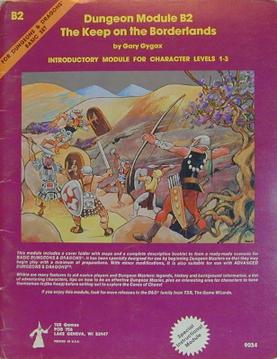
The Keep on the Borderlands is a Dungeons & Dragons adventure module by Gary Gygax, first printed in December 1979. In it, player characters are based at a keep and investigate a nearby series of caves that are filled with a variety of monsters. It was designed to be used with the Dungeons & Dragons Basic Set, and was included in the 1979–1982 editions of the Basic Set. It was designed for people new to Dungeons & Dragons.

Palace of the Silver Princess is an adventure module for the Dungeons & DragonsBasic Set. It was recalled on the same day it was released, then rewritten and re-released some months later. The original version, with an orange cover, was written in 1980 by Jean Wells. When the orange version was recalled, the module was rewritten by Tom Moldvay and released with a green cover. Writing credit on the second version was given to both Moldvay and Wells, although there was very little of Wells' original content in Moldvay's version.

In Search of the Unknown is a module for the Dungeons & Dragons roleplaying game, designed for use with the Basic Set of rules. It was written by game designer Mike Carr and was first published in 1978 by TSR, Inc. The module details a hidden complex known as the Caverns of Quasqueton. Reviewers considered it a good quality introduction to the game that was written in the so-called dungeon crawl style, where the primary goal of the players is the exploration of a dangerous labyrinth to battle monsters and obtain treasure.

Scourge of the Slave Lords (A1–4) is an adventure module for the Dungeons & Dragons fantasy role-playing game, published by TSR, Inc. in 1986. It combines the contents of four earlier modules, all set in the World of Greyhawk campaign setting and intended for use with Advanced Dungeons & Dragons first edition rules.
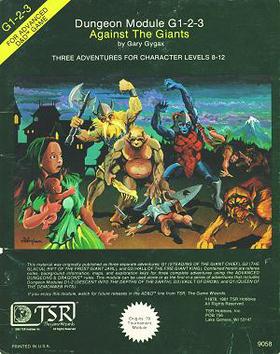
Against the Giants is an adventure module written by Gary Gygax and published by TSR in 1981 for the Dungeons & Dragons fantasy role-playing game. It combines the G series of modules previously published in 1978: Steading of the Hill Giant Chief, Glacial Rift of the Frost Giant Jarl, and Hall of the Fire Giant King. All three were produced for use with the 1st edition Advanced Dungeons & Dragons rules. In 1999, to recognize the 25th anniversary of TSR, the company released an updated version, Against the Giants: The Liberation of Geoff. Later in 1999, Wizards of the Coast published a novelization of Against the Giants by Ru Emerson.
The flexibility of the Dungeons & Dragons (D&D) game rules means that Dungeon Masters (DM) are free to create their own fantasy campaign settings. For those who wanted a pre-packaged setting in which to play, TSR, Wizards of the Coast (WotC), and other publishers have created many settings in which D&D games can be based; of these, the Forgotten Realms, an epic fantasy world, has been one of the most successful and critically acclaimed settings. Many campaign settings include standard sword and sorcery environments, while others borrow Asian, Central American, swashbuckling, horror and even space-travel themes.

The Hidden Shrine of Tamoachan is an adventure module for the Dungeons & Dragons (D&D) fantasy role-playing game, set in the World of Greyhawk campaign setting for use with the 1st edition Advanced Dungeons & Dragons rules. It is the first in the C-series of modules, a set of unrelated adventures originally designed for competitive play, with the C representing the first letter in the word competition. It is the first D&D adventure to use boxed, "read aloud" text.
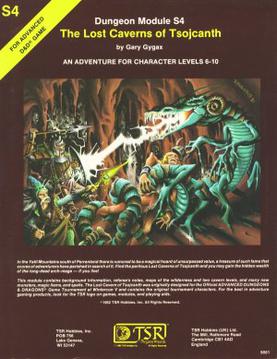
The Lost Caverns of Tsojcanth is an adventure module for the Dungeons & Dragons fantasy role-playing game. It was written by Gary Gygax and published by TSR in 1982 for the first edition Advanced Dungeons & Dragons (AD&D) rules. The 64-page adventure bears the code "S4" and is set in the Greyhawk campaign setting. It is divided into two parts, a 32-page adventure, and a 32-page booklet of monsters and magic items. The plot involves the player characters investigating rumors of lost treasure. After traversing a wilderness and two levels of dungeons, the players face Drelnza, the vampiric daughter of long-deceased archmage Iggwilv.
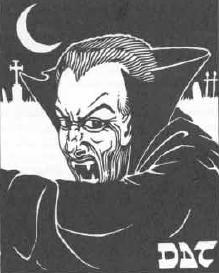
In the Dungeons & Dragons fantasy role-playing game, a vampire is an undead creature. A humanoid or monstrous humanoid creature can become a vampire, and looks as it did in life, with pale skin, haunting red eyes, and a feral cast to its features. A new vampire is created when another vampire drains the life out of a living creature. Its depiction is related to those in the 1930s and 1940s Hollywood Dracula and monster movies. In writing vampires into the game, as with other creatures arising in folklore, the authors had to consider what elements arising in more recent popular culture should be incorporated into their description and characteristics.
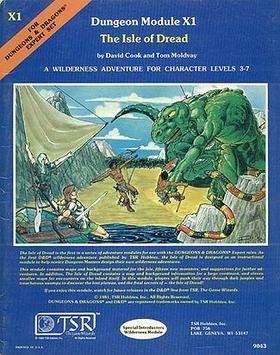
The Isle of Dread is an adventure for the Dungeons & Dragons role-playing game. The adventure, module code X1, was originally published in 1981. Written by David "Zeb" Cook and Tom Moldvay, it is among the most widely circulated of all Dungeons & Dragons adventures due to its inclusion as part of the D&D Expert Set. In the adventure, the player characters arrive on the Isle of Dread seeking a lost treasure, and there encounter new nonhuman races.
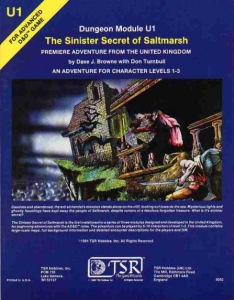
The Sinister Secret of Saltmarsh is a module for the Advanced Dungeons & Dragons (AD&D) roleplaying game, written by Dave J. Browne with Don Turnbull. The module details a mysterious abandoned mansion at the edge of a town called Saltmarsh, and the secrets contained therein. The adventure is set in the World of Greyhawk campaign setting. The Sinister Secret of Saltmarsh received positive reviews from critics.
Thomas Steven Moldvay was an American game designer and author, best known for his work on early materials for the fantasy role-playing game Dungeons & Dragons (D&D).

David "Zeb" Cook is an American game designer, best known for his work at TSR, Inc., where he was employed for over fifteen years. Cook designed several games, wrote the Expert Set for Dungeons & Dragons, worked as lead designer of the second edition of Advanced Dungeons & Dragons, and invented the Planescape setting for AD&D. He is a member of the Origins Hall of Fame.
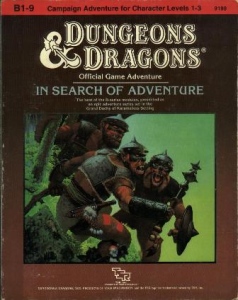
In Search of Adventure is an abridged compilation adventure module published by TSR, Inc. in 1987, for the Basic Set of the Dungeons & Dragons (D&D) fantasy role-playing game. Its product designation was TSR 9190. This 160-page book features cover artwork by Keith Parkinson.

The Dungeons & Dragons Basic Set is a set of rulebooks for the Dungeons & Dragons (D&D) fantasy role-playing game. First published in 1977, it saw a handful of revisions and reprintings. The first edition was written by J. Eric Holmes based on Gary Gygax and Dave Arneson's original work. Later editions were edited by Tom Moldvay, Frank Mentzer, Troy Denning, and Doug Stewart.

The Expert Set is an expansion boxed set for the Dungeons & Dragons fantasy role-playing game. It was first published in 1981 as an expansion to the Basic Set.

Twilight Calling is an adventure module for the Dungeons & Dragons fantasy role-playing game, set in that game's Mystara campaign setting. TSR, Inc. published the module in 1986 for the D&D Master Set rules. It is part of the "M" series of modules. The module was designed by Tom Moldvay with additional design, development and editing by Bruce Heard, Karen Martin, Rick Swan, Jennell Jaquays, Kevin Stein and Robin Jenkins. Its cover art is by Ben Otero, with interior art by Larry Elmore and cartography by Diane & Dave Sutherland, Gloria Szopinski and Rob Peacock.
















